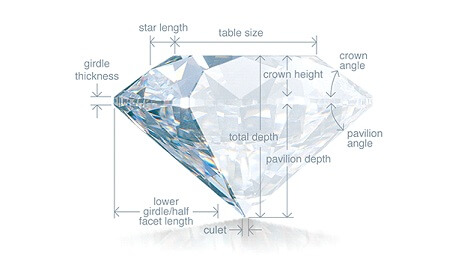DIAMOND COLOR
The diamond color evaluation of most gem-quality diamonds is based on the absence of color. A chemically pure and structurally perfect diamond has no hue, like a drop of pure water, and consequently, a higher value. D-to-Z diamond color-grading system measures the degree of colorlessness by comparing a stone under controlled lighting and precise viewing conditions to master stones of established color value.
Many of these color distinctions are so subtle that they are invisible to the untrained eye; however, these distinctions make a very big difference in diamond quality and price.

DIAMOND CLARITY
Natural diamonds are the result of carbon exposed to tremendous heat and pressure deep in the earth. This process can result in a variety of internal characteristics called ‘inclusions’ and external characteristics called ‘blemishes.’
Evaluating diamond clarity involves determining the number, size, relief, nature, and position of these characteristics, as well as how these affect the overall appearance of the stone. While no diamond is perfectly pure, the closer it comes, the higher its value.

DIAMAOND CARAT
Diamond carat weight is the measurement of how much a diamond weighs. A metric “carat” is defined as 200 milligrams.
Each carat can be subdivided into 100 ‘points.’ This allows very precise measurements to the hundredth decimal place. A jeweler may describe the weight of a diamond below one carat by its ‘points’ alone. For instance, the jeweler may refer to a diamond that weighs 0.25 carats as a ‘twenty-five pointer.’ Diamond weights greater than one carat are expressed in carats and decimals. A 1.08 carat stone would be described as ‘one point oh eight carats.’
DIAMOND CUT
When we speak of cut we are more interested in the proportions of the diamond as opposed to its shape (Round Brilliant, Marquise, Pear, Princess, etc.) Every diamond regardless of its shape gets it brilliancy and scintillation by cutting and polishing the diamond facets to allow the maximum amount of light that enters through its top to be reflected and dispersed back through its top. A correctly cut, "well made", stone is pictured in diagram 1. As you can see if the angles are correct the light that enters is dispersed properly back through the diamond's top facets. When a stone is cut too shallow (diagram2) or too deep (diagram3) the light that enters through the top is allowed to escape through the diamond's bottom and does not allow the maximum beauty of the diamond to be realized.









